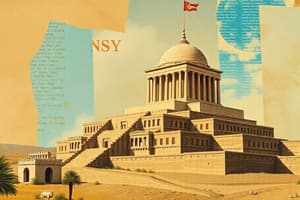Podcast
Questions and Answers
Which rivers are known as the 'in between rivers'?
Which rivers are known as the 'in between rivers'?
- Nile and Amazon
- Mississippi and Missouri
- Tigris and Euphrates (correct)
- Yangtze and Ganges
The fertile crescent is located primarily in Iraq.
The fertile crescent is located primarily in Iraq.
True (A)
Name one of the main civilizations that developed in the fertile crescent.
Name one of the main civilizations that developed in the fertile crescent.
Sumer
The ancient civilization of __________ was located in Northern Iraq and Southeastern Turkey.
The ancient civilization of __________ was located in Northern Iraq and Southeastern Turkey.
Match the following civilizations with their locations:
Match the following civilizations with their locations:
What type of bricks were used for decorative purposes in ancient Assyria and Babylon?
What type of bricks were used for decorative purposes in ancient Assyria and Babylon?
Ziggurats were built as open-type buildings due to extreme heat.
Ziggurats were built as open-type buildings due to extreme heat.
What building form is typically used in deserts due to the conditions?
What building form is typically used in deserts due to the conditions?
The ancient Persians used ______ and colored limestone in their construction.
The ancient Persians used ______ and colored limestone in their construction.
Match the following architectural features with their purposes or materials:
Match the following architectural features with their purposes or materials:
Which of the following structures was built by King Nebuchadnezzar II?
Which of the following structures was built by King Nebuchadnezzar II?
Hammurabi's Code was the first set of written laws in history.
Hammurabi's Code was the first set of written laws in history.
Who was the father of the Iranian Nation?
Who was the father of the Iranian Nation?
The architectural style used in Babylon and Assyria primarily involved the use of __________ and __________.
The architectural style used in Babylon and Assyria primarily involved the use of __________ and __________.
Match the following architects or rulers with their contributions:
Match the following architects or rulers with their contributions:
Which of the following served as the guard room and reception area?
Which of the following served as the guard room and reception area?
The Hall of the Hundred Columns is also known as The Throne Hall.
The Hall of the Hundred Columns is also known as The Throne Hall.
Who started the construction of the Hall of the Hundred Columns?
Who started the construction of the Hall of the Hundred Columns?
The Treasury served as the _______ and storehouse.
The Treasury served as the _______ and storehouse.
Match the following Persian rulers with their contributions:
Match the following Persian rulers with their contributions:
What is a key characteristic of West Asiatic architecture?
What is a key characteristic of West Asiatic architecture?
Mesopotamia means 'the land of many rivers'.
Mesopotamia means 'the land of many rivers'.
What does the Greek word 'mesos' signify in the context of Mesopotamia?
What does the Greek word 'mesos' signify in the context of Mesopotamia?
West Asiatic architecture is also known as ______ architecture.
West Asiatic architecture is also known as ______ architecture.
Match the following terms with their descriptions:
Match the following terms with their descriptions:
Flashcards are hidden until you start studying
Study Notes
Overview of West Asiatic Architecture
- Also known as Mesopotamian architecture.
- Originates from the region between the Tigris and Euphrates rivers, referred to as "the fertile crescent."
Geographical Significance
- "Mesopotamia" translates to "in between rivers" in Greek.
- Includes four main civilizations:
- Sumer in Iraq (from Baghdad to Persian Gulf)
- Babylon in Iraq
- Assyria in Northern Iraq and Southeastern Turkey
- Persia in Iran
Geological Materials
-
Assyria and Babylon:
- Utilized clay for brick-making.
- Developed sun-dried bricks for ordinary constructions.
- Created kiln-dried bricks for significant structures.
- Employed color-glazed bricks for decorative elements.
-
Persia:
- Employed timber and colored limestone in constructions.
Climatic Adaptations
-
Assyria & Babylon:
- Built temples on raised platforms to avoid flooding.
- Constructed Ziggurats (stepped towers) to accommodate environmental factors.
-
Persia:
- Designed open-type buildings to cope with extreme heat.
-
General design included courtyard forms to suit desert conditions.
Religious and Decorative Elements
- Religious architecture featured king-headed winged lions, bulls, and mythical monsters in palace doorway decorations.
Important Historical Figures
-
Sumer:
- King Ur-Nammu: Known for erecting the Great Ziggurat of Ur.
-
Babylonia:
- King Nebuchadnezzar II: Builder of significant structures including:
- The Great Palace of Nebuchadnezzar
- Ishtar Gate
- Hanging Garden of Babylon
- King Hammurabi: Authored the first known legal codes in cruciform known as Hammurabi's Code.
- King Nebuchadnezzar II: Builder of significant structures including:
-
Assyria:
- Sargon II: Built the Palace of Sargon in Khorsabad.
- Sennacherib: Established Nineveh as the Assyrian capital.
-
Persia:
- Cyrus the Great: Renowned as the founder of the Persian Empire.
- Xerxes I: Key constructor of Persepolis; initiated the Hall of the Hundred Columns and Gate of All Nations.
- Artaxerxes I: Completed the Palace of Persepolis and the Hall of the Hundred Columns.
Architectural Differences
- Construction Methods:
- Babylon and Assyria: Utilized arches and vaults, with buttressing techniques.
- Persia: Emphasized columnar and trabeated construction.
Notable Building Types
-
Babylon:
- The Treasury (under Darius I): Functioned as an arsenal and storehouse.
-
Hall of the Hundred Columns:
- Also known as the Throne Hall, characterized by columns with double bull and unicorn capitals; construction began under Xerxes I and completed by Artaxerxes I.
Studying That Suits You
Use AI to generate personalized quizzes and flashcards to suit your learning preferences.




